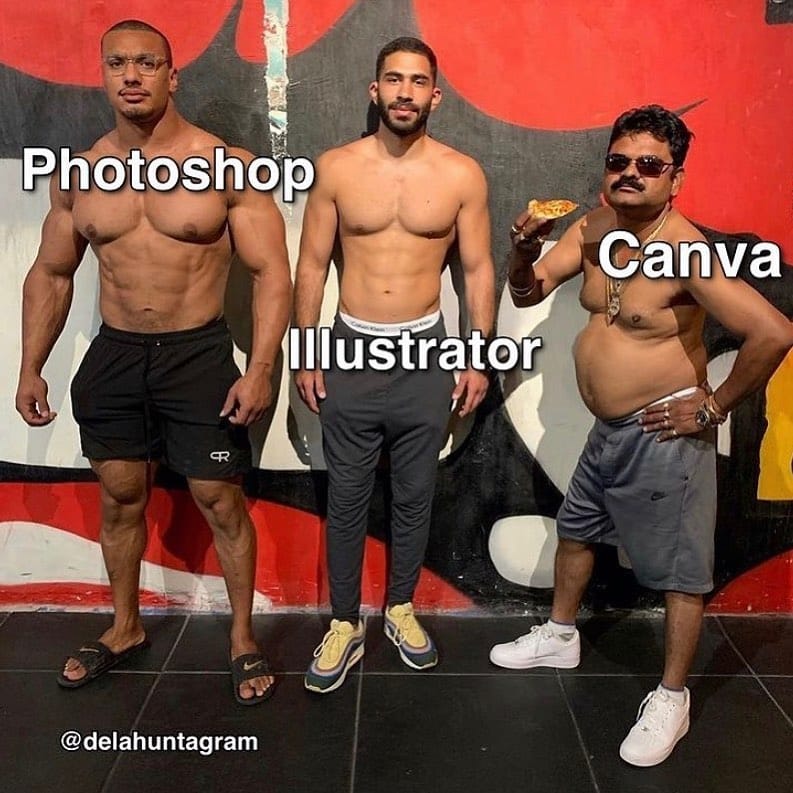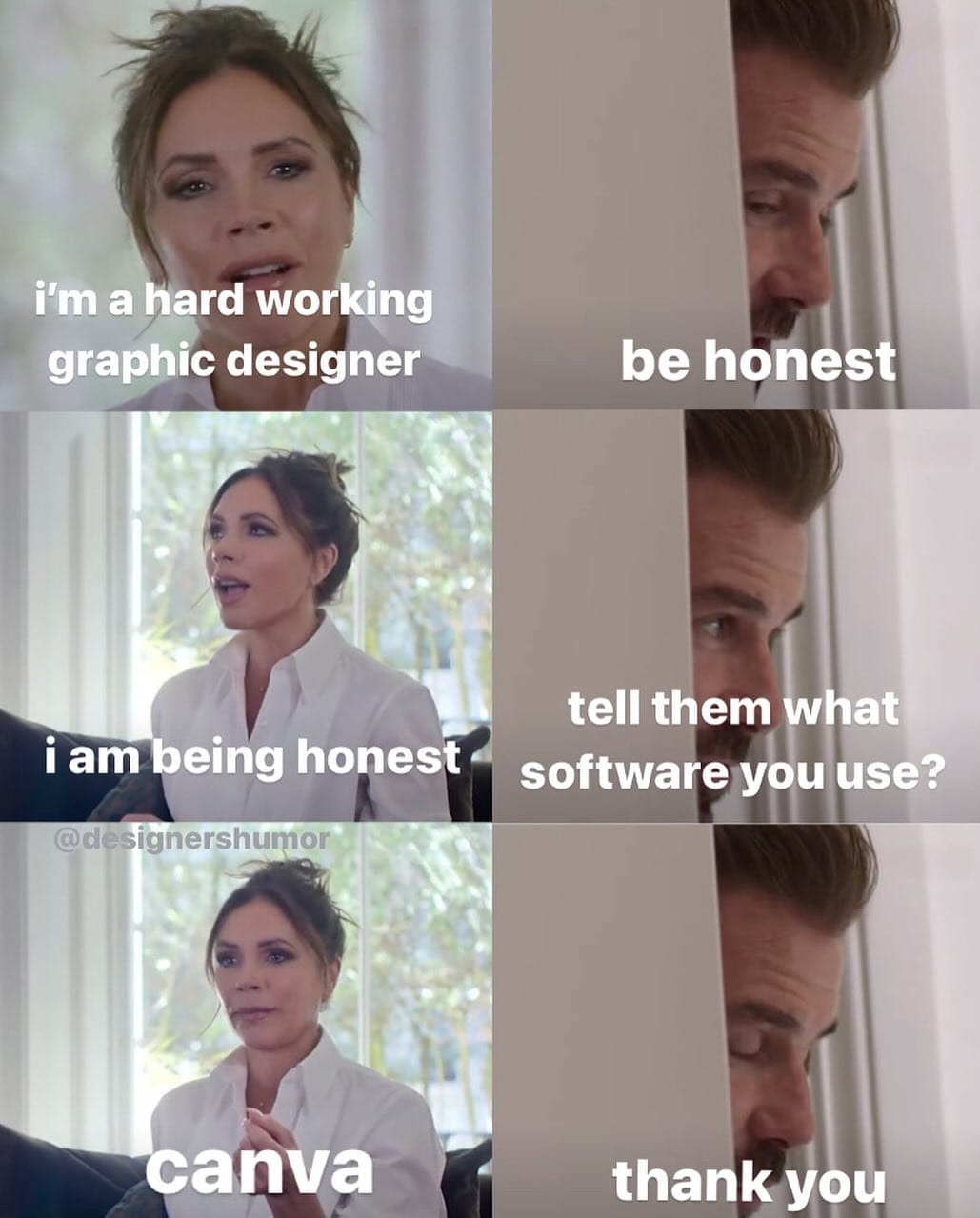Burn Your Subscription—Canva’s audacious play to disrupt publishing
It's their strategic intent.

Designers love to hate on Canva. For a long time, it’s been viewed as the dorky sibling to “real” design programs like those made by Adobe. I even had that elitist view after being thoroughly indoctrinated as a hipster and graduating from art school. Memes about "designers who use Canva" abound.


Meme credits @delahuntagram and @designershumor
But Canva’s goal has never been to be like Adobe or any of the big creativity and design tools. Its goal has been to disrupt the very nature of publishing and make good design accessible for all. And in that goal, they have succeeded to the nth degree.
Their acquisition of Serif (maker of Affinity) and the recent release of the newest version of the Affinity app takes direct aim at Adobe’s core business model, which is a subscription based product geared towards “pro designers.” The release video starts with full screen text that reads "BURN YOUR SUBSCRIPTION" How much more direct could they be?
Flipping the financial model
By making Affinity free, Canva is positioning itself to severely undercut Adobe's target market, which is itself increasingly frustrated by the rent vs. buy dilemma and increasing subscription cost. There are plenty of Reddit threads to corroborate this. Just search "Adobe alternatives" and grab a bag of popcorn.


At time of writing, a personal Adobe subscription for all apps costs $840/yr, with an individual business plan costing $1200/yr. When your team grows, that's a pretty heavy expense. Even a team of just four people would cost nearly $5,000/yr on a business plan. That's a hefty subscription for many organizations.
By contrast, the new version of Affinity is 100% free and a Canva Pro subscription (which gives you access to additional AI features in Affinity) is just $120/yr. That's just 14% of the cost of an Adobe personal plan and 10% of a business plan.
Now to be fair, Adobe is firmly entrenched as the "industry standard" for art and design, so the cost is relative and not based on 100% feature parity. There are lots of things that Adobe offers that Affinity can't do (yet?). For example, motion graphics, sophisticated audio editing, video, etc. But not every design or marketing department really needs those things, and if they do, there are legit alternatives (e.g., Davinci Resolve, Blender, Audacity, etc.) If you need foundational tools for raster, vector, photo editing, and layout, Affinity probably covers 99.99% of those use cases.
Canva is in effect saying, “We’re commodifying pro design tools and going for Adobe's jugular." Burn your subscription indeed. The knives are out and the play is savage.
Picking a fight with the publishing status quo
It’s important to keep in mind that Melanie Perkins, the founder of Canva, had a vision to transform publishing when she was just 19 years old. In a 2019 interview on How I Built this with Guy Raz she says:
It seemed completely silly that you'd take so many instruction manuals and so many steps through the most basic of things. Students would take a whole semester just learning where the buttons were to learn how to design something. It seemed very apparent that this whole desktop-based thing would be completely archaic and outdated in the future. So I had this very oversized vision for taking on all of these different industries from Microsoft Office and lots and lots of other industries as well.
She started the company not with a plan to produce a Unicorn, but with a vision to transform how people create and publish. She knew how to "start with why." (Canva ultimately reached Unicorn status in 2019—just 6 years after launching.) Unicorn status came by picking a fight with the publishing and design industry as a whole. She also had an intuition that design would move from the desktop to the cloud. That's the same bet Figma made, and wow has that paid off. In Rework, Jason Fried and David Heinemeier Hansson write:
If you think a competitor sucks, say so. When you do that, you'll find that others who agree with you will rally to your side. Being the anti-_______________ is a great way to differentiate yourself and attract followers.
Melanie Perkins started by picking a major fight against some industry giants, and she hasn't backed down since 2013 (when Canva was founded). That's 12 years of chugging along in spite of intense competition. The vision to transform publishing has remained remarkably clear as the product has grown. The retooling of Affinity is a logical progression in that direction. By making the product free, Canva is opening the doors for more designers who are hesitant to enter the field because of software costs. And now the company is able to serve at least three audiences.:
- The non-designer who needs to make something look good in a jiffy. (Massive Total Addressable Market)
- The pro designer who knows how to make sick comps and layouts but who may also need to crank out a bunch of bulk assets in Canva to scale a campaign. (Lots and lots of small but mighty marketing teams.)
- Solo designers and teams that are tired of footing a significant subscription bill from Adobe.
In any case, Canva has built a solid company and user base in its core product, and I can't really see how this move would be anything but a boon to the company's growth.
Growth by strategic intent
The key to Canva's success and the impetus to relaunch Affinity as a pointed salvo toward Adobe hinges on Perkins's audacious vision to build the future of publishing. In their 1989 Harvard Business Review article "Strategic Intent", Gary Hamel and C.K. Prahalad write:
Companies that have risen to global leadership over the past 20 years invariably began with ambitions that were out of all proportion to their resources and capabilities. But they created an obsession with winning at all levels of the organization and then sustained that obsession over the 10- to 20- year quest for global leadership. We term this obsession "strategic intent."
Canva's strategic intent has been part of its DNA ever since Melanie Perkins pitched the idea to Bay Area investors in 2012. In fact, the vision was crystalized in the slide deck she used to get their initial funding. Here's how Perkins describes the pitch on How I Built This (edited for clarity):
Guy Raz: Okay, so let's say I'm one of these investors you're meeting with in the Bay Area. I would say, "So yeah, this looks cool, but I have a lot of questions for you Melanie. First of all, tech team. Where's your tech team?" You would say what?
Melanie Perkins: "So we've already built a company with Fusion Books [a yearbook design company that preceeded Canva], we've demonstrated that we can make a profitable company that's been able to grow. We've launched internationally, and we're just going to take it on to the biggest stage." I can totally understand why nobody wanted to invest in us.
Guy: And then I would say, "But look Microsoft or Google, the minute they see what you guys do, they'll crush you because they'll just put something else out way bigger, and I mean, you're just going to get crushed right away."
Melanie: You sound totally like one of those investors.
Guy: And what would you say?
Melanie: We'd say, "There is this huge gap in the market, because to actually create this huge industry—the future of publishing—you would have to completely cannibalize your industry. And if you look at the areas of publishing over the years, we started off with metal plates, and then we moved into the type-setting and paste up"—this actually became the second slide in our pitch deck—"and we then moved into the desktop era, and then we're now moving into this new era, which we believe is going to be online. And what you'll see, dear investor, is that there is no industry player who's actually ever been able to go from one industry to the next and actually still maintain being the market leader. And so every single time there was a new era, a new market leader emerged. And so we believe that market leader can be us."
That's what I'd call an out-of-proportion vision if I ever saw one. And just look at the results. We are witnessing the art and design empire being reshaped in real time.
What's next for Affinity (and design software in general)
This is not the kind of development that sizzles and fades almost instantaneously. This is the kind of move that will be discussed in business school and among creatives and in intricately nested Reddit and X threads. Here's what I'm anticipating and looking forward to.
Possibility 1: Market correction
Perhaps this will force Adobe to cut its subscription costs to maintain market share. In that case, this release could be a tool for correcting price inflation in the market.
Possibility 2: Growing awareness of alternatives
At the same time, I hope this launch will get more people to look at art and design alternatives including and beyond Affinity. There are many open source applications like Gimp, Inkscape, Krita, and more that can be totally sufficient for many creative endeavors. I'd love to see more development investment in free and open source tools.
Possibility 3: Canva has to prove and earn trust (Is free really free?)
The art and design community has expressed grave concerns about whether Affinity with remain free forever, whether features will eventually be locked behind a paywall, and whether Canva can be trusted to not use your work to train AI since you have to sign up for a (free) Canva account to use Affinity. I personally feel like Canva would be hard-pressed to do anything shiesty after such a massive, public re-launch of Affinity. Reneging on the original value proposition would do nothing but tarnish brand image—and the design community would not forget it. Folks were concerned about what Canva would do to Affinity as soon as the company purchased Serif in 2024, but I think they're doing a reasonable job of being a good steward of the Serif legacy while moving the product forward.
Possibility 4: What about a Linux version?
Then there's the issue of operating system. Affinity is only available for MacOS and Windows, with an iPad version coming soon. If Canva released an Affinity version that ran on Linux, I think it would spread like wildfire. Having a unified tool for comps, vectors, and layout would be incredible. I think Adobe would have a massive amount of work to port all of its apps over to Linux, but Affinity is a single app that does everything and saves projects as a single file format (.af). I'm no software engineer, but a Linux version of Affinity seems like far less work. It would be cool if they released it for just one or two distros like Ubuntu and Fedora and just worked from there.
How I'm approaching this Affinity release

For my part, I've already downloaded Affinity, and I plan on exploring it as my projects require. On first glance, I really like how the app lets you move across different workspaces for Pixel, Vector, and Layout tasks, which could really speed up workflows that require round-tripping between Photoshop, Illustrator, and InDesign. I've already used it to do some light edits on some logos for web design, and I've felt right at home in the interface.
I work in a marketing department with sufficient budget for whatever software I need, and yet I've still been frustrated at the cost of our Adobe subscription (and I'm the only one on it). The Adobe apps I use the most are Lightroom and Premiere, and I do 95% of my design work in Canva (oh how the turn tables). This release may be a major stepping stone for me to get out of the Adobe ecosystem.
I also have pro designer friends as well as friends who design as part of their day job, and I'm already spreading the word. If you already use Canva, using Affinity is a no-brainer. And having worked as the Communications Director at a large church, we used Canva for so many things and Canva was free for nonprofits for up to 50 people. If that model remains, tons of great organizations will be able to have high quality design software and advanced features for free. That's a tremendous gift to humanity.
While I don't know exactly what will happen now, I am excited to see such a direct challenge to Adobe's hegemony. Big strategic moves have major seismic impacts. This is the type of move that will continue to have aftershocks in the industry for a long time—waaaay after the social media buzz moves on to the next trending topic.
One thing is clear: It will be very interesting to see how Adobe has to zag in response to Canva's zig.



